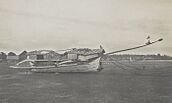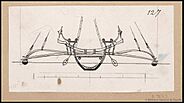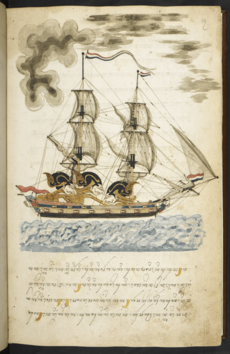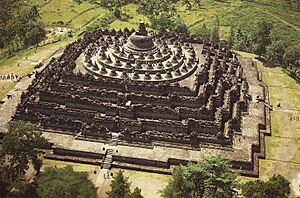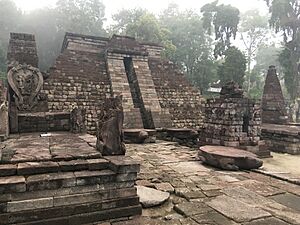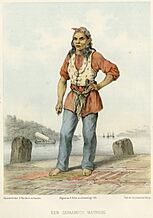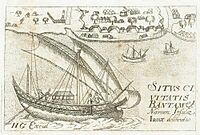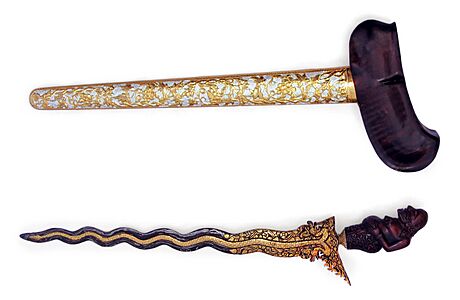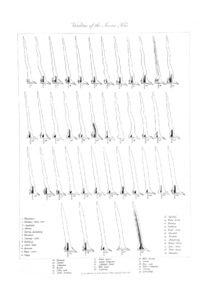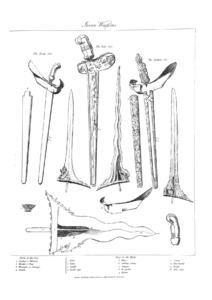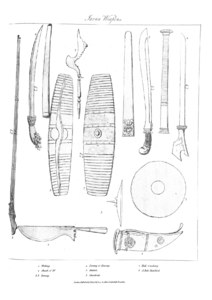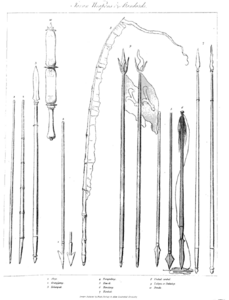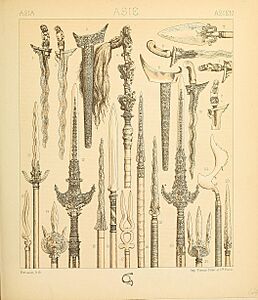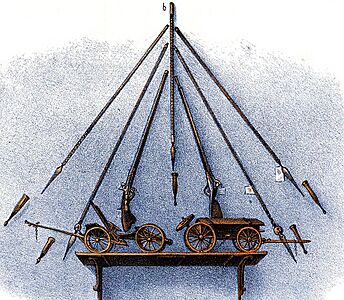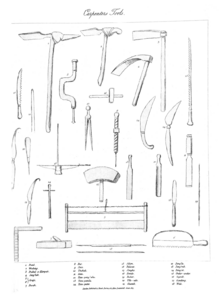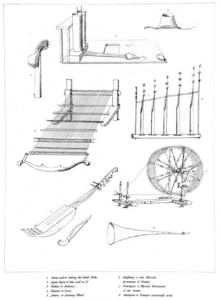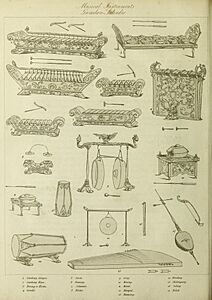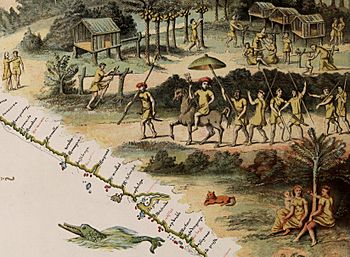Javanese people facts for kids
|
|
|---|---|
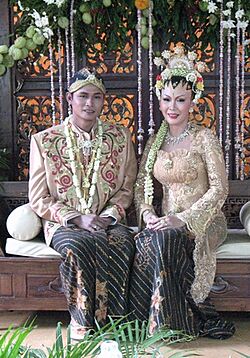
A Javanese bride and groom in traditional wedding dresses
|
|
| Total population | |
| More than 100 million | |
| Regions with significant populations | |
| 98,217,022 (2010) | |
| c. 1,500,000 (including Malaysian citizens counted as "Malays") | |
| 1,000,000 (2014) (Javanese and Indonesian descent are often referred to as 'Al-Jawi' which means people from the Javanese islands (modern Indonesia)) | |
| c. 400,000 (including Singaporean citizens, more than 60% of Singaporean Malays are of Javanese descent) | |
| 102,000 (2019) (Javanese Surinamese) | |
| 21,700 | |
| 8,500 | |
| 4,100 | |
| 3,000 | |
| Languages | |
|
|
| Religion | |
| Predominantly Sunni Islam (97.15%) Minorities Christianity 2.56% (1.59% Protestant and 0.97% Roman Catholic), Hinduism (0.17%), Buddhist (0.10%), Others (0.01%) |
|
| Related ethnic groups | |
The Javanese people are a large ethnic group from the island of Java in Indonesia. They live mostly in the central and eastern parts of Java. With over 100 million people, they are the biggest ethnic group in Indonesia and all of Southeast Asia. Their main language is Javanese, which is the largest Austronesian language by native speakers.
Javanese culture has been shaped by many influences over time. These include ancient local beliefs, and the Hindu and Buddhist cultures from India. These influences can still be seen in their history, traditions, and art. Ancient Javanese kingdoms like Singhasari and Majapahit were powerful empires. They built amazing temples like Borobudur and Prambanan, which are some of the biggest in the world.
Many Javanese people live outside Java, in other parts of Indonesia and countries like Suriname, Singapore, and Malaysia. Most Javanese are Sunni Muslims, but some are Christians or Hindus. They are one of the largest Muslim groups in the world.
History
Like many groups in Indonesia, the Javanese are Austronesian. Their ancestors likely came from Taiwan, traveling through the Philippines to Java around 1,500 to 1,000 BC.
Ancient Javanese Kingdoms and Empires
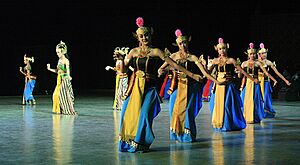
Hindu and Buddhist ideas came to Java through trade with India around the 5th century. These Indian beliefs mixed with local Javanese faiths, creating a unique culture.
The first Javanese kingdoms, like Sanjaya and Sailendra, grew in the fertile plains near Mount Merapi. Between the late 700s and mid-800s, many beautiful temples were built. These include Kalasan, Sewu, Borobudur, and Prambanan. At its strongest, the Javanese kingdom was a powerful empire. It controlled not only Java but also parts of Sumatra, Bali, and other areas in Southeast Asia.
Later, the center of Javanese power moved eastward in the 10th century. This move might have been because of a volcanic eruption or an invasion.
In the late 1200s, King Kertanegara of Singhasari expanded Javanese influence. He sent expeditions to other islands and controlled trade routes. His rule ended when he was killed in a rebellion.
However, his son-in-law, Raden Wijaya, defeated the rebels with the help of Mongol troops. Raden Wijaya then founded the Majapahit kingdom.
The Majapahit empire became very powerful under King Hayam Wuruk and his minister Gajah Mada (1350-1389). They expanded the empire across Southeast Asia, making Majapahit one of the most important empires in the region's history. Javanese kingdoms were active in the spice trade, exchanging rice for spices.
Javanese Sultanates
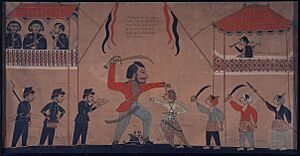
Islam began to spread in Java through port cities on the northern coast. Religious teachers, known as Wali Songo, are traditionally credited with spreading Islam among the Javanese.
As Islam grew, the Majapahit empire declined. The Sultanate of Demak became the new strong power on Java's northern coast. Demak also controlled ports in Sumatra and fought against the Portuguese who arrived in the region. Demak attacked the Portuguese after they captured Malacca.
Later, the Sultanate of Mataram became the most powerful Javanese kingdom. It reached its peak under Sultan Agung (1613-1645).
Colonial Java
In 1619, the Dutch set up their trading base in Batavia (now Jakarta). Java slowly came under the control of the Dutch East India Company. Internal conflicts and Dutch interference caused the Mataram Sultanate to split into smaller kingdoms like Surakarta and Yogyakarta. Even though the Dutch held the real power, the Javanese kings in their palaces (keratons) still had great respect.
The British briefly ruled Java in the early 1800s. During this time, Stamford Raffles helped rediscover Borobudur. The Javanese fought against foreign rule, most famously in the Java War (1825-1830) led by Prince Diponegoro.
During World War II, Japan took control of Java. After Japan's defeat, Indonesia declared its independence on August 17, 1945.
Republic of Indonesia
After Indonesia declared independence, the last Javanese monarchies joined the new Republic of Indonesia. The Sultan of Yogyakarta and the Prince of Pakualaman became the Governor and Vice-Governor of the Yogyakarta Special Region. This special region was officially created in 1950. Surakarta became part of the Central Java province.
Culture
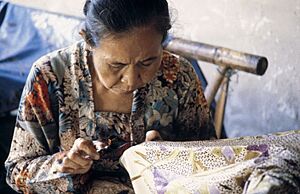
Javanese culture is one of the oldest and richest in Southeast Asia. It has blended many influences over time. These include respect for ancestors, Buddhist and Hindu values, and Islamic traditions. Javanese culture, especially in the royal courts of Yogyakarta and Surakarta, values elegance, politeness, and emotional control. Javanese people highly value harmony and social order, avoiding direct conflict.
These values are often shown through Javanese arts like Javanese dance, gamelan music, wayang (shadow puppetry), and batik cloth. They are also part of traditional ceremonies like Slametan and Javanese weddings.
However, Javanese culture along the northern coast is a bit different. People there tend to be more open to new ideas and less focused on social status. These port towns were among the first places where Islam spread in Java.
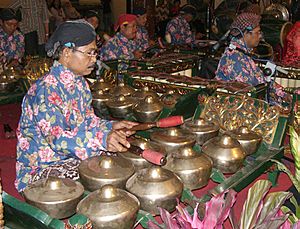
Javanese culture is mainly found in Central Java, Yogyakarta, and East Java. But because many Javanese people have moved, their culture can also be found in places like Suriname, Malaysia, and Singapore. Migrants bring their traditions, such as Gamelan music and Wayang kulit, with them.
Language
Javanese is part of the Austronesian language family. It is related to, but different from, other Indonesian languages. It has many words borrowed from Sanskrit because of the long history of Hindu and Buddhist influences in Java.
Many Javanese people in Indonesia speak both Indonesian and Javanese.
The Javanese language used to be written with its own script, called Hanacaraka or Carakan, which came from the Brahmi script. It could also be written with the Arabic script called Pegon. After Indonesia became independent, the Latin alphabet became the main way to write Javanese.
Javanese is not an official language of Indonesia, but it is an important regional language in Javanese-majority areas. It is a key part of Javanese identity.
Literature and Philosophy
Javanese writers and poets are known for creating deep philosophical ideas and sayings. Many famous sayings come from Javanese literature and traditions. For example, "Bhinneka Tunggal Ika" (Unity in Diversity) is Indonesia's national motto. Other popular sayings include "Gemah Ripah Loh Jinawi, Toto Tentrem Kerto Raharjo" and "Tut Wuri Handayani".
Calendar
The Javanese people use the Javanese calendar along with the Gregorian calendar and the Islamic calendar. The Gregorian calendar is Indonesia's official calendar. The Islamic calendar is used for religious events. The Javanese calendar is mostly used for cultural events, like Siji Suro.
The Javanese calendar is a lunar calendar, adopted by Sultan Agung in 1633. Before that, they used a solar calendar based on the Hindu calendar.
Unlike many other calendars, the Javanese calendar has a 5-day week called the Pasaran cycle. This cycle is combined with the 7-day week to create a 35-day cycle called the Wetonan cycle.
Architecture
Historical Temples in Java
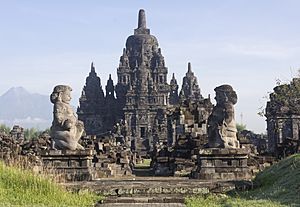
Throughout their history, the Javanese have built many important structures. These include Hindu monuments, Buddhist temples, palaces, and mosques.
Before Islam became widespread (from the 5th to 15th centuries), Hinduism and Buddhism were the main religions in Java. Many Hindu temples, called Candi, were built. Local stories say that thousands of temples were buried by a huge eruption of Mount Merapi in 1006 AD.
Two very important religious sites are the Hindu temple of Prambanan and the Buddhist temple of Borobudur. Both were built in the 9th century and are UNESCO World Heritage Sites. They are located near Yogyakarta.
The ruins of the former capital of the Majapahit Kingdom (14th to 16th century AD) in Trowulan, East Java, show examples of non-religious buildings. The site includes brick buildings, canals, pools, and unique split gates.
Traditional Javanese Buildings
Traditional Javanese buildings often have trapezoid-shaped roofs supported by wooden pillars. Another common feature is the pendopo, an open-sided pavilion with four large pillars. These pillars and other parts of the buildings can have beautiful wood carvings. This style can be seen in the kraton, or palaces, of the Sultans in Yogyakarta and Surakarta.
Traditional mosques in Java also have a distinct Javanese style. They often use the pendopo design for prayer halls. Instead of the typical Muslim dome, they have trapezoidal, multi-tiered roofs. Many traditional Javanese mosques also do not have minarets. The split gate, common in earlier Hindu-Buddhist times, is still used in many mosques and public buildings in Java.
Famous examples of mosques with traditional Javanese architecture include the Agung Demak Mosque and the Menara Kudus Mosque. The Kudus Mosque is special because it includes Hindu-style stone architecture.
Cuisine

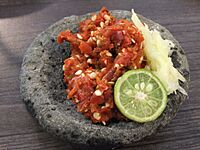
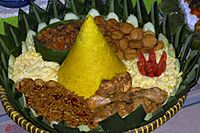
Rice is the most important food in Javanese cooking. A meal is not complete without it. Rice is also a symbol of Javanese culture and prosperity.
Javanese food tastes different depending on the region. Eastern Java prefers spicy and salty foods, while Central Javanese food tends to be sweeter.
A famous Javanese dish is Rujak Cingur. It's made with marinated cow lips and noses, served with vegetables, shrimp crackers, and a peanut sauce with chili. Rujak Cingur is a traditional food from Surabaya in East Java.
Gudeg is a traditional dish from Yogyakarta and Central Java. It's made from young jack fruit boiled for hours with palm sugar and coconut milk.
Pecel, a type of peanut sauce with chili, is common in Javanese cooking. It's used in different kinds of Rujak and Gado-gado. It can also be served with rice, prawns, eggs, and vegetables as Nasi Pecel.
Tumpeng is rice shaped like a conical volcano, often colored yellow with turmeric. It's a very important part of many Javanese ceremonies, like birthdays or moving to a new house. Tumpeng is usually served with fried chicken, boiled egg, vegetables, and goat meat on a round bamboo plate called besek.
A notable Javanese food is tempeh, a meat substitute made from soybeans fermented with mold. It's a main source of protein in Java and is popular worldwide, especially for vegetarians.
Names
Javanese people usually have only one name and do not use family names. Many Javanese names come from traditional Javanese words, often from Sanskrit. Names starting with Su-, meaning good, are very common. After Islam arrived, many Javanese started using Arabic names, especially in coastal areas where Islamic influence was stronger.
Common people usually have one-word names. Noble families might use two or more words, but rarely a surname. Some people use a patronymic (a name based on their father's name). Because of other cultures, many people now use names from other languages, especially European ones. Christian Javanese often use a Latin baptism name followed by a traditional Javanese name.
Religion
| Religions | Total |
|---|---|
| Islam | 92,107,046 |
| Protestant | 1,506,208 |
| Roman Catholic | 921,913 |
| Hinduism | 150,855 |
| Buddhism | 90,465 |
| Others | 12,456 |
| Overall | 94,788,943 |
Religion of Javanese Sunni Islam (97.17%) Protestantism (1.59%) Roman Catholic (0.97%) Hinduism (0.16%) Buddhism (0.10%) Other, mostly Kejawen (0.01%)
Most Javanese people today officially follow Sunni Islam. The first record of Islam in Java dates back to 1082 AD. However, Islam spread more widely during the Majapahit period through trade. Muslim tombstones from the 14th century have been found near the Majapahit capital, showing that Muslims were close to the royal court.
A smaller group of Javanese (about 3%) are Christians (Protestant and Catholic). They are mainly found in Central Java and Yogyakarta. There are also native Javanese Christian churches. Even smaller numbers of Javanese follow Hinduism and Buddhism. The Tengger tribe in the Mount Bromo area still practice Javanese-Hinduism.
Kebatinan, also known as Kejawèn, is a Javanese spiritual tradition. It combines elements of local beliefs, Hindu-Buddhist ideas, and Islamic (especially Sufi) practices. It is a unique blend of different religions rooted in Javanese history.
Occupations
Javanese people work in all kinds of jobs in Indonesia, especially in government and the military.
Farming
Traditionally, most Javanese people are farmers. Java's fertile volcanic soil makes it great for farming. Rice is the most important crop. In 1997, Java produced 55% of Indonesia's total rice. Most farmers work on small rice fields. In areas with less fertile soil or short rainy seasons, other crops like cassava are grown.
Merchant-Sailor
Javanese merchants and sailors traveled the seas between India and China as early as the 1st century CE. Javanese ships even attacked coastal cities in Champa (modern-day Vietnam) in the late 700s.
Javanese people may have reached Australia in the 10th century AD. There are records of black laborers being brought to Java from places like Zanzibar and Papua.
In the 10th century, Arab accounts describe people called Wakwak (possibly Javanese) invading Africa. They arrived with 1000 boats to get goods like ivory and black slaves. The presence of black Africans was recorded in Java until the 15th century.
The Malagasy people of Madagascar have genetic links to Southeast Asian groups. Parts of the Malagasy language come from the Ma'anyan language with Javanese or Malay words. This suggests Javanese and Malay traders might have brought Ma'anyan people to Madagascar as laborers or slaves.
During the Majapahit era, Java was a major trading hub. Javanese ships, especially large ones called jong, traveled far. European accounts from the early 1500s noted that Javanese merchants visited many places, including the Maluku Islands, China, and even the Red Sea. A Javanese map from this time even showed parts of the Americas.
Javanese sailors used advanced navigation systems. They used natural signs and "star path navigation" to find their way. In the Majapahit era, they used compasses and developed cartography (map-making). The Portuguese even thought Javanese maps were the best in the early 1500s.
European colonial rule reduced the range of Javanese merchant-sailors. In the mid-1600s, the Mataram Sultanate destroyed ships and closed ports to prevent rebellions. Later, the Dutch restricted Javanese sailing to short distances.
Shipbuilder
- Borobudur ship from Borobudur temple, 8th century AD
- Javanese jong in Banten bay, 1610
The Javanese were known for building large ships called K'un-lun po. These ships sailed between India and China as early as the 2nd century CE. They could carry up to 1000 people and a lot of cargo. These ships were large, had multiple wooden planks, and used unique stitching techniques.
Javanese trading in Africa influenced boatbuilding in Madagascar and East Africa. This can be seen in the use of outriggers and eye ornaments on African boats.
Another large Javanese ship was the jong, first mentioned in the 9th century. During the Majapahit era, a jong could carry 600-700 men and 1200-1400 tons of cargo. The largest ones carried 1000 men and 2000 tons. Jong ships were built in shipbuilding centers in Java and Borneo.
The Portuguese were impressed by Javanese shipbuilding skills. They hired 60 Javanese carpenters to work in India. The Dutch also recognized Javanese skill; in the 18th century, Javanese people worked as foremen in Amsterdam shipyards. However, Dutch rule later limited Javanese shipbuilding.
Blacksmith
-
Weapons of Java: machetes, maces, bows and arrows, blowpipes, and slings.
-
Javanese weapons and standards.
-
Javanese weapons: Spears, an istinggar and senapan, and a model of a cannon.
Blacksmiths are highly respected in Javanese culture. Some blacksmiths even fast and meditate to improve their skills. Javanese blacksmiths make tools, farming equipment, and cultural items like gamelan instruments and kris (a special dagger). The skills used to make kris were also used to make guns. Cannons and firearms needed special expertise and were likely made by the same people.
The Majapahit empire used gunpowder technology from China for its navy. Pole guns were used by Javanese people in 1413.
In the early 1500s, Duarte Barbosa noted that Javanese people were skilled at making artillery and using it. They made many cannons, long muskets, and other firearms. In 1513, a Javanese fleet attacked Portuguese Malacca with "much artillery made in Java."
The kris knife is a very important item. Many heirloom kris have great historical value. The design of the kris is meant to cause severe injury.
Kota Gede is famous for its silverwork and silver handicrafts.
Javanese people also made several types of armor and steel helmets. Armor was probably used by high-ranking soldiers. Javanese armies often included peasant soldiers who fought bare-chested.
Batik Making
Batik cloth is worn by both men and women. The patterns can show social status. Batik is also used in ceremonies. Certain designs are believed to bring good luck to newborns or newly married couples. Some towns specialize in making batik, such as Pekalongan and Laweyan.
Wood Carving
The Javanese art of wood carving is used for statues, wayang dolls, and masks. Wood carving is also important for decorating houses. The elaborately carved Omah Kudus is a great example of Javanese wood carving skill. The town of Jepara in Central Java is famous for its Javanese wood carving workshops, especially using Javanese teak wood.
-
Javanese woodworkers making traditional masks during the Dutch East Indies era.
Migrations
The Javanese were likely involved in the migration of Austronesian people to Madagascar around the first centuries CE. While the culture is linked to the Ma'anyan people of Borneo, some words in the Malagasy language come from Javanese. This suggests that Javanese traders might have brought Ma'anyan people to Madagascar.
A Portuguese account from 1645 described the Javanese as skilled sailors. They claimed the Javanese had sailed to the Cape of Good Hope and communicated with Madagascar.
Since the time of Hindu kingdoms, Javanese merchants settled in many parts of the Indonesian archipelago. In the late 1400s, after the Majapahit empire fell, many Hindu nobles and artists moved to Bali. There, they helped create Bali's refined culture. Others who did not want to convert to Islam retreated to the Tengger mountains, keeping their Hindu religion.
During conflicts in the late 1500s, some Javanese moved to Palembang in southern Sumatra. They formed a sultanate there, mixing Malay and Javanese cultures. The Palembang language is a Malay dialect with strong Javanese influence.
A book from 1613 described a Javanese king's voyage to a southern land called Luca Antara (possibly northern Australia). The book said that a group of Javanese people had already settled there. Their customs and appearance were similar to Javanese from West Java, with only slight language differences.
During the reign of Sultan Agung of Mataram (1613–1645), some Javanese settled in coastal West Java. These settlements were originally rice farming villages to support Sultan Agung's army against the Dutch.
Javanese people were also present in Peninsular Malaya early on. The link between Java and Malacca was important for the spread of Islam in Indonesia. Large migrations to the Malay Peninsula happened during the colonial period, mostly from Central Java to British Malaya. These migrations were to find a new life away from the Dutch colonists. Today, these people live throughout Peninsular Malaysia.
In Singapore, about 50-60% of the "Malay" population has some Javanese ancestry. Most of them identify as "Malays" rather than Javanese.
Javanese merchants were also in the Maluku Islands for the spice trade. After Java became Islamic, they helped spread Islam to these islands. Javanese merchants also converted coastal cities in Borneo to Islam. Thus, the Javanese played a key role in spreading Islam from western to eastern parts of the archipelago through trade.

New migration patterns appeared during colonial times. When the VOC gained power in the 17th century, many Javanese were exiled, enslaved, or hired as soldiers for Dutch colonies. These included princes and nobles who lost power and were sent away with their followers. They became part of ethnic groups like the Sri Lankan Malay and Cape Malay.
Major migrations began under Dutch colonial transmigration programs. The Dutch needed many workers for their plantations. They moved many Javanese as contract workers, mostly to other parts of Indonesia like Sumatra. They also sent Javanese workers to Suriname in South America. As of 2019, about 13.7% of Suriname's population has Javanese ancestry. Javanese workers were also sent to plantations in New Caledonia, a French territory.
The transmigration program continued after Indonesia gained independence. A large Javanese population can be found in the Jabodetabek (Greater Jakarta) area, Lampung, South Sumatra, and Jambi provinces. These Javanese immigrants formed community organizations like "Pujakesuma" (Sumatra-born Javanese).
Notable people
See also
- Javanese Malaysian
- Javanese Singaporean
- Javanese New Caledonians
- Javanese Surinamese
- Budi Utomo
- Kejawèn
- Subud
- Saminism Movement
- Javanese cuisine
- Javanese literature
- Javanese Kshatriya
- Javanisation
- Hinduism in Java
- Sundanese people
- Indonesians in Hong Kong
- Indonesians in Saudi Arabia
- Indonesians in Taiwan



